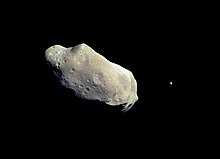Colonization of the asteroid belt: Difference between revisions
Appearance
Content deleted Content added
| Line 19: | Line 19: | ||
*Most asteroids are far from the Sun. The main asteroid belt is roughly 2 to 4 times further from the Sun than Earth. This means that the available solar energy ([[solar constant]]) is 4 to 16 times less, although building large reflectors to collect sunlight is possible in space. |
*Most asteroids are far from the Sun. The main asteroid belt is roughly 2 to 4 times further from the Sun than Earth. This means that the available solar energy ([[solar constant]]) is 4 to 16 times less, although building large reflectors to collect sunlight is possible in space. |
||
*Many asteroids may merely be loose agglomerations of dust and rocks, which may be very difficult to use. |
*Many asteroids may merely be loose agglomerations of dust and rocks, which may be very difficult to use. |
||
*Asteroids are vulnerable to [[Solar radiation]], lacking similarities like Earth's [[ozone layer]] and [[magnetosphere]] (though some may have a magnetic field, they are bound to be considerably weaker by comparison) |
*Asteroids are vulnerable to [[Solar radiation]], lacking similarities like Earth's [[ozone layer]] and [[magnetosphere]] (though some may have a magnetic field, they are bound to be considerably weaker by comparison). Shielding with several meters of asteroidal regolith is a trivial solution to this problem. |
||
*Asteroids have no or very little atmosphere. |
*Asteroids have no or very little atmosphere. |
||
*Smaller objects may collide with the asteroid and cause significant damage. |
*Smaller objects may collide with the asteroid and cause significant damage. |
||
Revision as of 15:29, 14 April 2010
The asteroids have long been suggested as possible sites for human colonization. This idea is popular in science fiction. Asteroid mining, a proposed industrial process in which asteroids are mined for valuable materials, especially platinum group metals, may be automated or require a crew to remain at the target asteroid.
Advantages
- Low gravity simplifies construction technologies (such as cranes) and reduces structural strength requirements
- Large number of possible sites, with over 300,000 asteroids identified to date
- Asteroids contain several chemical composition classes, including iron and carbonaceous, providing a variety of materials usable in building and fueling spacecraft and space habitats. The Trojan asteroids, in Jupiter's orbit may be primarily extinct comets.
- Some Earth-crossing asteroids require less energy (delta-V) to reach from Earth than the Moon.
- Material mined from asteroids could be a basis for a trade economy
- Low gravity significantly eases transportation of material from asteroids, goods among asteroids and transport of large amounts of mass or massive objects
- High surface/volume ratio enables effective exploration and exploitation of mineral resources and provides maximal portion of useful building ground on the surface and underground
- High vacuum and low gravity would facilitate the evolution of some hi-tech industries such as material engineering and physical electronics (crystal growth, epitaxy)
- Many asteroids (especially the extinct comet cores) contain large amounts (more than 5% of total composition) of volatiles and carbon, which are necessary for life support.
- Isaac Asimov pointed out the advantage of building cities inside hollowed out asteroids since the interior area in square miles of all the asteroids put together is a great deal more than that of the surface area of Earth (viewed as a series of cubes one mile (1.6 km) by one mile resting on the surface of Earth) and thus a large population could be accommodated in the asteroid belt.
Disadvantages
- Low gravity. Humans would have to adapt, or some form of artificial gravity would have to be implemented.
- Most asteroids are far from the Sun. The main asteroid belt is roughly 2 to 4 times further from the Sun than Earth. This means that the available solar energy (solar constant) is 4 to 16 times less, although building large reflectors to collect sunlight is possible in space.
- Many asteroids may merely be loose agglomerations of dust and rocks, which may be very difficult to use.
- Asteroids are vulnerable to Solar radiation, lacking similarities like Earth's ozone layer and magnetosphere (though some may have a magnetic field, they are bound to be considerably weaker by comparison). Shielding with several meters of asteroidal regolith is a trivial solution to this problem.
- Asteroids have no or very little atmosphere.
- Smaller objects may collide with the asteroid and cause significant damage.
Asteroids of special interest

- (6178) 1986 DA is a potentially metallic near-Earth asteroid.
- 216 Kleopatra is a metallic main-belt asteroid.
Some C-type asteroids are likely carbonaceous chondrites, which are some tens of percent water by mass.
Asteroid colonies in science fiction
- See Asteroids in fiction.
References
- David Gump, Space Enterprise: Beyond NASA, Praeger Publishers, 1990, ISBN 0-275-93314-8.
- Mining the Sky: Untold Riches from the Asteroids, Comets, and Planets
- The Technical and Economic Feasibility of Mining the Near-Earth Asteroids, M. J. Sonter.
- Template:Wayback, IEEE Spectrum, August 2001.
